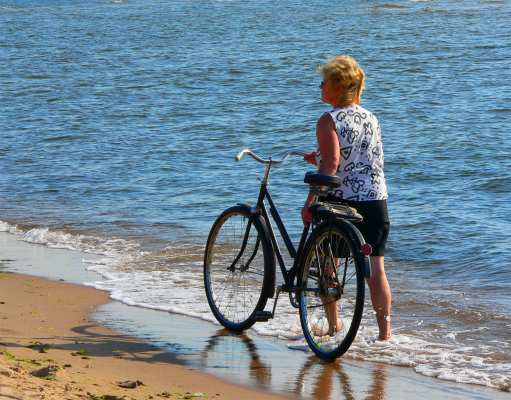
Years ago, before cycling became mainstream, cyclists always waved to one another when crossing paths. A sense of camaraderie existed between them; it seemed almost like a code of honor.
Most of these cyclists were men, as are most road cyclists today. So, the rules of conduct were more clear, or at least there were clear expectations in terms of cyclist interactions.
As anyone who rides a bike knows, no matter how careful you are, eventually you will get a flat tire or experience a mechanical failure while out on the road. Often, this happens when you are riding alone.
Pulling over and finding a spot to prop up a disabled bike can be a real nuisance. On heavily trafficked roads, there may not be an open area to work on a bike. And on rural roads, there may not be enough room to pull a bike completely off of the road.
Then there is the problem of light. Many riders, especially commuters, ride in the dark, either in the morning or at night. This can result in a breakdown in unlit areas. Finding enough light in such situations can be difficult for anyone who doesn’t use a helmet-mounted light.
Depending upon who a cyclist is, he or she may feel more or less comfortable pulling over and fixing a bike. Mechanically inclined individuals with a lot of experience repairing bikes may consider a small repair to be trivial.
Less experienced cyclists may rarely have occasion to fix a flat, let alone do a roadside repair. For them, getting stranded could be a daunting experience. And the prospect of having to spend a lot of time sitting on the side of the road struggling to patch or change a tube could become overwhelming.
Traditionally, one cyclist called out to another cyclist to find out whether he was okay or whether he needed help. If the cyclist needed help, he would ask the passing cyclist for items like a tire patch, a tube or a pump. Even if the passing cyclist didn’t have any of those things, he would often stop for a moment to see if there was anything else he could do to help out. If not, after determining that the stranded cyclist was all right on his own, he would ride off.
Over time, the number of cyclists grew. With that growth came more female cyclists. While this was a good thing, it changed the rules somewhat.
Social norms create a barrier between unacquainted men and women in public places. It’s impolite for a man to approach a strange woman under most circumstances. Women do not welcome such attention. They also don’t approach strange men.
With this in mind, it becomes difficult to determine where female riders fall with respect to cycling camaraderie. Given social dictates, a man must wonder whether it is acceptable to wave to a female rider as one would wave to a man. Does this wave have the same connotation as waving to a man or would it be taken as an unwelcome advance?
And what about saying “hello” at a traffic light? When a man and woman are standing together waiting to cross the street, they don’t speak to one another. Yet, male and female cyclists do, on occasion, greet one another when they pull up beside each other at a light. In fact, they sometimes fall into conversation, even if it is only chitchat about what a nice day it is for a bike ride.
Waving or saying hello at a light are innocuous enough. Few people would feel threatened by such actions. But is the same true when it comes to a stranded cyclist?
Men rarely think twice when approached by a stranger — unless, of course, that stranger is carrying a weapon. Women, on the other hand, are often wary of strange men. They don’t know what the man’s intentions are or whether it is safe to engage in conversation with him.
Unlike men, women have to be cautious and aware of their surroundings. In addition, with the advances women have made in society over the last thirty years, many women are independent and take it as an insult if a man offers to help them with something they are capable of doing on their own. This makes offering help to a stranded female cyclist a tricky proposition for a man.
If there were more female cyclists, it would be less of a problem. Women could stop to help other women, negating the need for male involvement. But, with the scarcity of female cyclists on the roads, a stranded female cyclist could wait for a very long time before another woman came along to offer assistance.
The fact that a male is riding a bicycle might alleviate a female cyclist’s concerns about him to some degree. After all, they are engaging in the same activity; it’s not like he’s just a random guy driving by. Perhaps in this context, an offer of assistance would be taken as a chivalrous gesture. Perhaps not; it’s hard to know how an individual woman will react.
Despite these uncertainties, it’s probably best for both male and female cyclists to help each other as much as possible. Very few towing services exist for cyclists. And waiting for a friend or relative to drive out and rescue you can be a frustrating experience.
As cycling becomes better accepted as a legitimate form of transportation, methods of dealing with cycling breakdowns may become part of the transportation system. In the meantime, let’s hope that cycling chivalry is not dead and that damsels in distress will not take offense at sincere offers of assistance.



